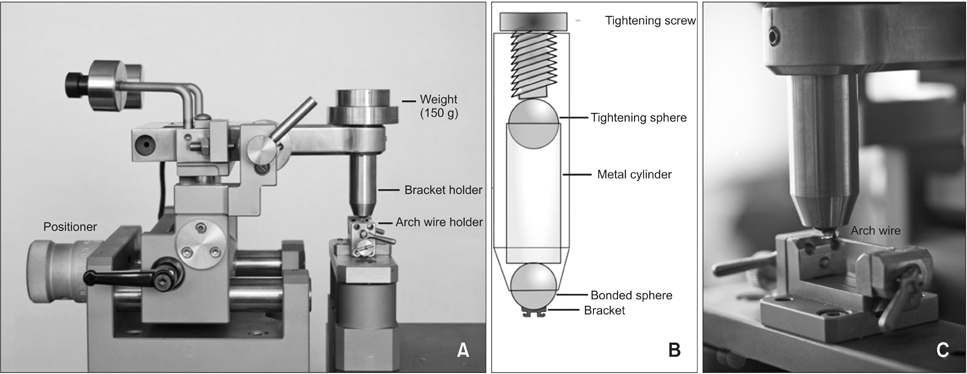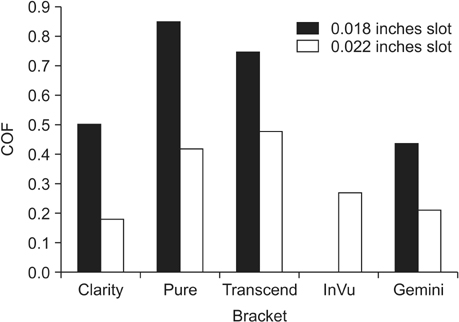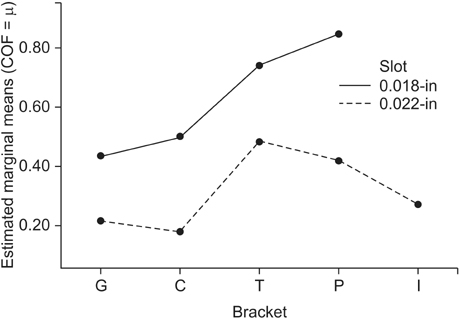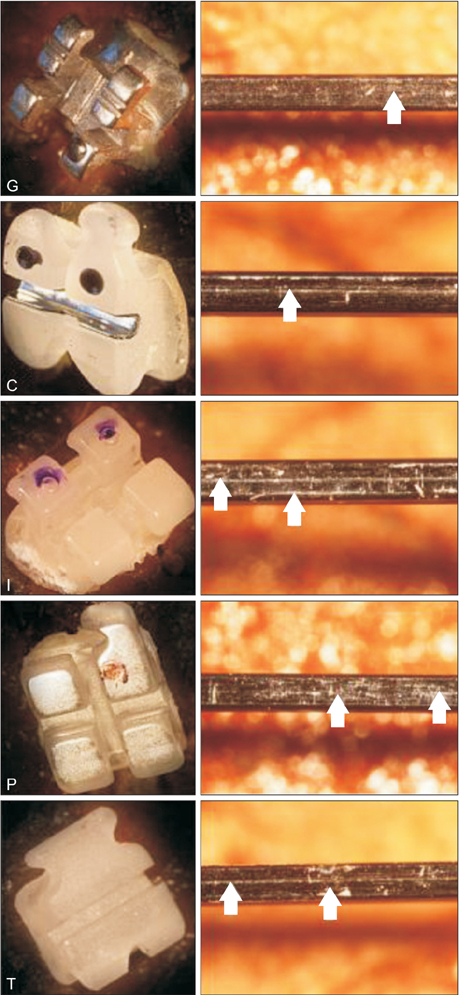Korean J Orthod.
2015 Jan;45(1):29-37. 10.4041/kjod.2015.45.1.29.
Comparison of the frictional characteristics of aesthetic orthodontic brackets measured using a modified in vitro technique
- Affiliations
-
- 1Department of Orthodontics, Faculty of Dentistry, Ondokuz Mayis University, Samsun, Turkey. nurselarici@omu.edu.tr
- KMID: 2074820
- DOI: http://doi.org/10.4041/kjod.2015.45.1.29
Abstract
OBJECTIVE
The coefficients of friction (COFs) of aesthetic ceramic and stainless steel brackets used in conjunction with stainless steel archwires were investigated using a modified linear tribometer and special computer software, and the effects of the bracket slot size (0.018 inches [in] or 0.022 in) and materials (ceramic or metal) on the COF were determined.
METHODS
Four types of ceramic (one with a stainless steel slot) and one conventional stainless steel bracket were tested with two types of archwire sizes: a 0.017 x 0.025-in wire in the 0.018-in slots and a 0.019 x 0.025-in wire in the 0.022-in slot brackets. For pairwise comparisons between the 0.018-in and 0.022-in slot sizes in the same bracket, an independent sample t-test was used. One-way and two-way analysis of variance (ANOVA) and Tukey's post-hoc test at the 95% confidence level (alpha = 0.05) were also used for statistical analyses.
RESULTS
There were significant differences between the 0.022-in and 0.018-in slot sizes for the same brand of bracket. ANOVA also showed that both slot size and bracket slot material had significant effects on COF values (p < 0.001). The ceramic bracket with a 0.022-in stainless steel slot showed the lowest mean COF (micro = 0.18), followed by the conventional stainless steel bracket with a 0.022-in slot (micro = 0.21). The monocrystalline alumina ceramic bracket with a 0.018-in slot had the highest COF (micro = 0.85).
CONCLUSIONS
Brackets with stainless steel slots exhibit lower COFs than ceramic slot brackets. All brackets show lower COFs as the slot size increases.
Keyword
MeSH Terms
Figure
Cited by 1 articles
-
Resistance to sliding in orthodontics: misconception or method error? A systematic review and a proposal of a test protocol
Fabio Savoldi, Aggeliki Papoutsi, Simona Dianiskova, Domenico Dalessandri, Stefano Bonetti, James K. H. Tsoi, Jukka P. Matinlinna, Corrado Paganelli
Korean J Orthod. 2018;48(4):268-280. doi: 10.4041/kjod.2018.48.4.268.
Reference
-
1. Frank CA, Nikolai RJ. A comparative study of frictional resistances between orthodontic bracket and arch wire. Am J Orthod. 1980; 78:593–609.
Article2. Braun S, Bluestein M, Moore BK, Benson G. Friction in perspective. Am J Orthod Dentofacial Orthop. 1999; 115:619–627.
Article3. Cacciafesta V, Sfondrini MF, Ricciardi A, Scribante A, Klersy C, Auricchio F. Evaluation of friction of stainless steel and esthetic self-ligating brackets in various bracket-archwire combinations. Am J Orthod Dentofacial Orthop. 2003; 124:395–402.
Article4. Drescher D, Bourauel C, Schumacher HA. Frictional forces between bracket and arch wire. Am J Orthod Dentofacial Orthop. 1989; 96:397–404.
Article5. Read-Ward GE, Jones SP, Davies EH. A comparison of self-ligating and conventional orthodontic bracket systems. Br J Orthod. 1997; 24:309–317.
Article6. Kusy RP, Whitley JQ, Prewitt MJ. Comparison of the frictional coefficients for selected archwire-bracket slot combinations in the dry and wet states. Angle Orthod. 1991; 61:293–302.7. Kusy RP, Whitley JQ. Effects of sliding velocity on the coefficients of friction in a model orthodontic system. Dent Mater. 1989; 5:235–240.
Article8. Saunders CR, Kusy RP. Surface topography and frictional characteristics of ceramic brackets. Am J Orthod Dentofacial Orthop. 1994; 106:76–87.
Article9. Stannard JG, Gau JM, Hanna MA. Comparative friction of orthodontic wires under dry and wet conditions. Am J Orthod. 1986; 89:485–491.
Article10. Willems G, Clocheret K, Celis JP, Verbeke G, Chatzicharalampous E, Carels C. Frictional behavior of stainless steel bracket-wire combinations subjected to small oscillating displacements. Am J Orthod Dentofacial Orthop. 2001; 120:371–377.
Article11. Clocheret K, Willems G, Carels C, Celis JP. Dynamic frictional behaviour of orthodontic archwires and brackets. Eur J Orthod. 2004; 26:163–170.
Article12. Kusy RP, Whitley JQ. Influence of fluid media on the frictional coefficients in orthodontic sliding. Semin Orthod. 2003; 9:281–289.
Article13. Kusy RP, Whitley JQ. Friction between different wire-bracket configurations and materials. Semin Orthod. 1997; 3:166–177.14. Zinelis S, Eliades T, Eliades G, Makou M, Silikas N. Comparative assessment of the roughness, hardness, and wear resistance of aesthetic bracket materials. Dent Mater. 2005; 21:890–894.
Article15. Bazakidou E, Nanda RS, Duncanson MG Jr, Sinha P. Evaluation of frictional resistance in esthetic brackets. Am J Orthod Dentofacial Orthop. 1997; 112:138–144.
Article16. Cha JY, Kim KS, Hwang CJ. Friction of conventional and silica-insert ceramic brackets in various bracket-wire combinations. Angle Orthod. 2007; 77:100–107.
Article17. Reicheneder CA, Baumert U, Gedrange T, Proff P, Faltermeier A, Muessig D. Frictional properties of aesthetic brackets. Eur J Orthod. 2007; 29:359–365.
Article18. Cacciafesta V, Sfondrini MF, Scribante A, Klersy C, Auricchio F. Evaluation of friction of conventional and metal-insert ceramic brackets in various bracket-archwire combinations. Am J Orthod Dentofacial Orthop. 2003; 124:403–409.
Article19. Pizzoni L, Ravnholt G, Melsen B. Frictional forces related to self-ligating brackets. Eur J Orthod. 1998; 20:283–291.
Article20. Franchi L, Baccetti T, Camporesi M, Lupoli M. Maxillary arch changes during leveling and aligning with fixed appliances and low-friction ligatures. Am J Orthod Dentofacial Orthop. 2006; 130:88–91.
Article21. Pratten DH, Popli K, Germane N, Gunsolley JC. Frictional resistance of ceramic and stainless steel orthodontic brackets. Am J Orthod Dentofacial Orthop. 1990; 98:398–403.
Article22. Kapur R, Sinha PK, Nanda RS. Frictional resistance in orthodontic brackets with repeated use. Am J Orthod Dentofacial Orthop. 1999; 116:400–404.
Article23. Russell JS. Aesthetic orthodontic brackets. J Orthod. 2005; 32:146–163.24. Kusy RP, Whitley JQ. Frictional resistances of metal-lined ceramic brackets versus conventional stainless steel brackets and development of 3-D friction maps. Angle Orthod. 2001; 71:364–374.25. De Franco DJ, Spiller RE Jr, von Fraunhofer JA. Frictional resistances using Teflon-coated ligatures with various bracket-archwire combinations. Angle Orthod. 1995; 65:63–72.26. Omana HM, Moore RN, Bagby MD. Frictional properties of metal and ceramic brackets. J Clin Orthod. 1992; 26:425–432.27. Burrow SJ. Friction and resistance to sliding in orthodontics: a critical review. Am J Orthod Dentofacial Orthop. 2009; 135:442–447.
Article28. Rock WP, Wilson HJ. The effect of bracket type and ligation method upon forces exerted by orthodontic archwires. Br J Orthod. 1989; 16:213–217.
Article29. Kusy RP, Whitley JQ. Influence of archwire and bracket dimensions on sliding mechanics: derivations and determinations of the critical contact angles for binding. Eur J Orthod. 1999; 21:199–208.
Article
- Full Text Links
- Actions
-
Cited
- CITED
-
- Close
- Share
- Similar articles
-
- A study on frictional resistance force of orthodontic resin bracket
- A comparative study of frictional resistances between orthodontic brackets and arch wire during sliding movement of teeth
- Frictional resistance of different ceramic brackets and their relationship to the second order angulation between bracket slot and wire
- A comparative study of frictional force in self-ligating brackets according to the bracket-archwire angulation, bracket material, and wire type
- Friction of calcium phosphate brackets to stainless steel wire





